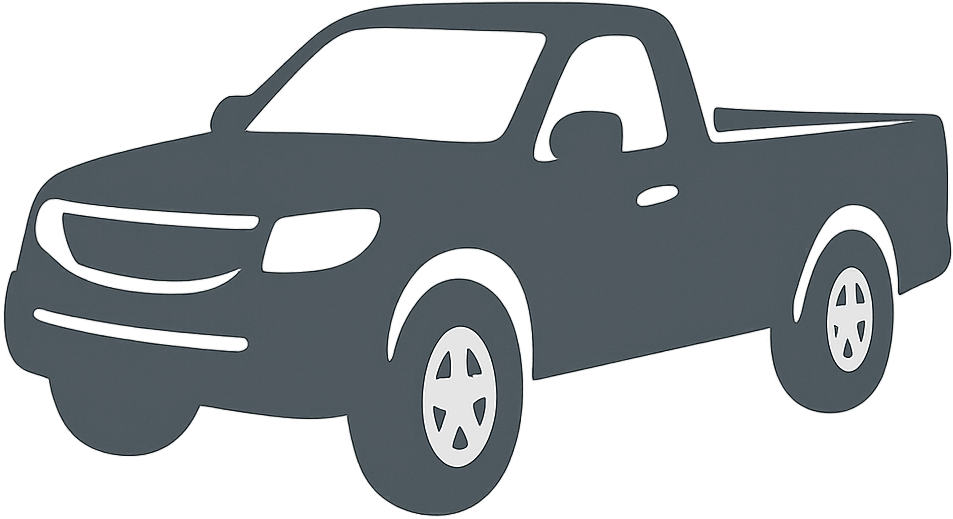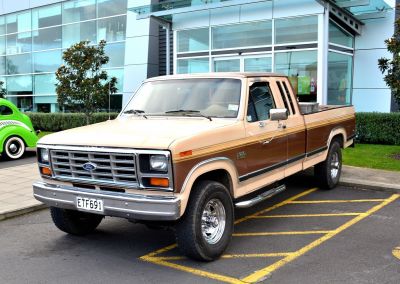 1980 Ford F-Series F-150 VII SuperCab Dimensions, Size & Specs
1980 Ford F-Series F-150 VII SuperCab Dimensions, Size & Specs
Measurements of the 1980 Ford F-Series F-150 VII SuperCab, engineered for optimal performance and comfort
| Dimensions | |
|---|---|
| Length: | 5438-5850 mm214.1-230.3 in17.8-19.2 ft |
| Width: | 1778 mm70.0 in5.8 ft |
| Height: | 1791-1867 mm70.5-73.5 in5.9-6.1 ft |
| Weight Specifications | |
| Maximal permitted Weight: | 2858-2926 kg6301-6451 lbs |
| Tire Specifications | |
| Rims Size: |
|
| Tire Sizes: |
|
The 1980 Ford F-Series F-150 VII SuperCab is a robust and versatile pickup truck that was produced between 1979 and 1986. This generation of the F-150 offered a blend of utility and style, catering to both work-oriented users and personal truck enthusiasts. Measuring between 5438 mm to 5850 mm (approximately 214 inches to 230 inches) in length, the truck provides ample space for cargo and passenger comfort. Its width stands at 1778 mm (70 inches), which ensures good road stability without compromising maneuverability. The height varies from 1791 mm to 1867 mm (around 70.5 inches to 73.5 inches), reflecting the differences between specific trims and configurations, including the SuperCab feature that adds passenger space behind the front seats.
This generation’s maximum weight ranges from 2858 kg to 2926 kg (6310 lbs to 6450 lbs), accounting for optional equipment and configurations. The truck rides on 15-inch rims, complemented by tire sizes 225/75 R15 and 235/75 R15, tailored for durability and performance on various terrains. Overall, the Ford F-Series F-150 VII SuperCab from 1980 offers a strong presence with balanced dimensions ideal for a classic full-sized pickup, ensuring it remains a significant model in Ford's rich truck history.
Discover the standout features that make the 1980 Ford F-Series F-150 VII SuperCab a leader in its class
Have a question? Please check our knowledgebase first.
The 1980 Ford F-Series F-150 VII SuperCab has a length ranging from 5438 mm to 5850 mm (approximately 214.1 to 230.3 inches). Its width is consistent at 1778 mm (about 70 inches). The height varies between 1791 mm and 1867 mm (around 70.5 to 73.5 inches), depending on specific configurations. These dimensions reflect the pickup's robust stance and provide ample space for cargo and passengers, typical of full-size trucks during this era.
The maximum weight of the 1980 Ford F-Series F-150 VII SuperCab lies between 2858 kg and 2926 kg (approximately 6299 to 6451 pounds). This weight range includes the truck loaded with its maximum allowable payload and equipment. The vehicle's sturdy frame and suspension ensure it can handle heavy-duty tasks, making it suitable for work and recreational use.
The 1980 Ford F-Series F-150 VII SuperCab's size can challenge some standard residential garages. With a maximum length of up to 5850 mm (230.3 inches / 19.2 feet), width of 1778 mm (70 inches / 5.8 feet), and height up to 1867 mm (73.5 inches / 6.1 feet), it would fit into garages designed for full-size vehicles but may be tight in compact or single-car garages. Homeowners should measure their garage space before assuming the truck will fit comfortably, especially in terms of height and length.
The Ford F-150 VII SuperCab from 1980 measures 1778 mm (70 inches) in width, which was quite standard among full-size pickup trucks of the late 1970s and early 1980s. This width provided a balance between interior roominess and exterior footprint, allowing the truck to navigate roads and parking spaces without excessive difficulty. Compared to competitors like the Chevrolet C/K series or Dodge D-Series of that era, the width is very similar, reflecting typical full-size truck dimensions.
The 1980 Ford F-150 VII SuperCab typically comes equipped with 15-inch rims. The common tire sizes are 225/75 R15 and 235/75 R15. These tires offered a good balance between off-road capability, load carrying capacity, and ride comfort, matching the truck's dual role as a workhorse and everyday vehicle.
The height variation from 1791 mm (70.5 inches) to 1867 mm (73.5 inches) in the 1980 Ford F-150 VII SuperCab can be attributed to factors such as suspension configurations, tire sizes, and optional equipment. A higher ride height can offer better ground clearance, beneficial for off-road driving and heavier loads, but may slightly affect fuel economy and stability at high speeds. Meanwhile, a lower height might improve aerodynamics and ease loading, highlighting the versatility of the truck based on owner preferences.
Compared to its predecessor (the sixth generation F-Series produced until 1979), the 1980 Ford F-150 VII SuperCab introduced subtle but meaningful dimension changes. The new generation expanded in length—up to 5850 mm (230.3 inches)—offering more cabin and cargo space. Width remained stable around 1778 mm (70 inches), maintaining road presence and maneuverability. Height saw slight increases, peaking near 1867 mm (73.5 inches), aligned with modernized suspension and cab designs. Overall, the truck became slightly larger, improving interior comfort and utility while retaining the ruggedness of the earlier models.
In 1980, the Ford F-150 VII SuperCab was highly competitive in the full-size pickup segment. Its length ranged from 5438 mm to 5850 mm (214.1 to 230.3 inches), which was comparable to rivals like the Chevrolet Silverado and Dodge Ram from that era. The width at 1778 mm (70 inches) was typical, providing enough interior space without becoming cumbersome. Height was also on par but sometimes a bit taller, especially with suspension upgrades, enhancing ground clearance for off-road tasks. In summary, the F-150 offered a blend of size and capability that matched or slightly exceeded competitors in terms of space and practicality.
The SuperCab configuration of the 1980 Ford F-150 VII featured an extended cab, which means it offered additional interior space behind the front seats compared to the traditional two-door regular cab. This extra space allowed for occasional rear passenger seating or increased storage inside the cabin. The design made the truck more versatile, suitable for families or workers who needed to carry extra passengers or secure tools and equipment inside the vehicle without resorting to the open bed.
The 1980 Ford F-150 VII SuperCab typically used 15-inch rims paired with tires sized at 225/75 R15 or 235/75 R15. These relatively large tires with higher sidewalls contributed to better off-road performance, shock absorption, and load-bearing capacity, essential for a pickup truck designed for work and rugged use. The tire dimensions provide a good balance of grip and comfort, improving traction on unpaved roads and ensuring stability when carrying heavy loads. These specifications helped maintain the truck’s durability and reliability across various driving conditions.
Discover similar sized cars.

| Production: | 1979-1986 |
|---|---|
| Model Year: | 1980 |
| Length: | 5438-5850 mm214.1-230.3 in |
| Width: | 1778 mm70.0 in |
| Height: | 1836-1910 mm72.3-75.2 in |
